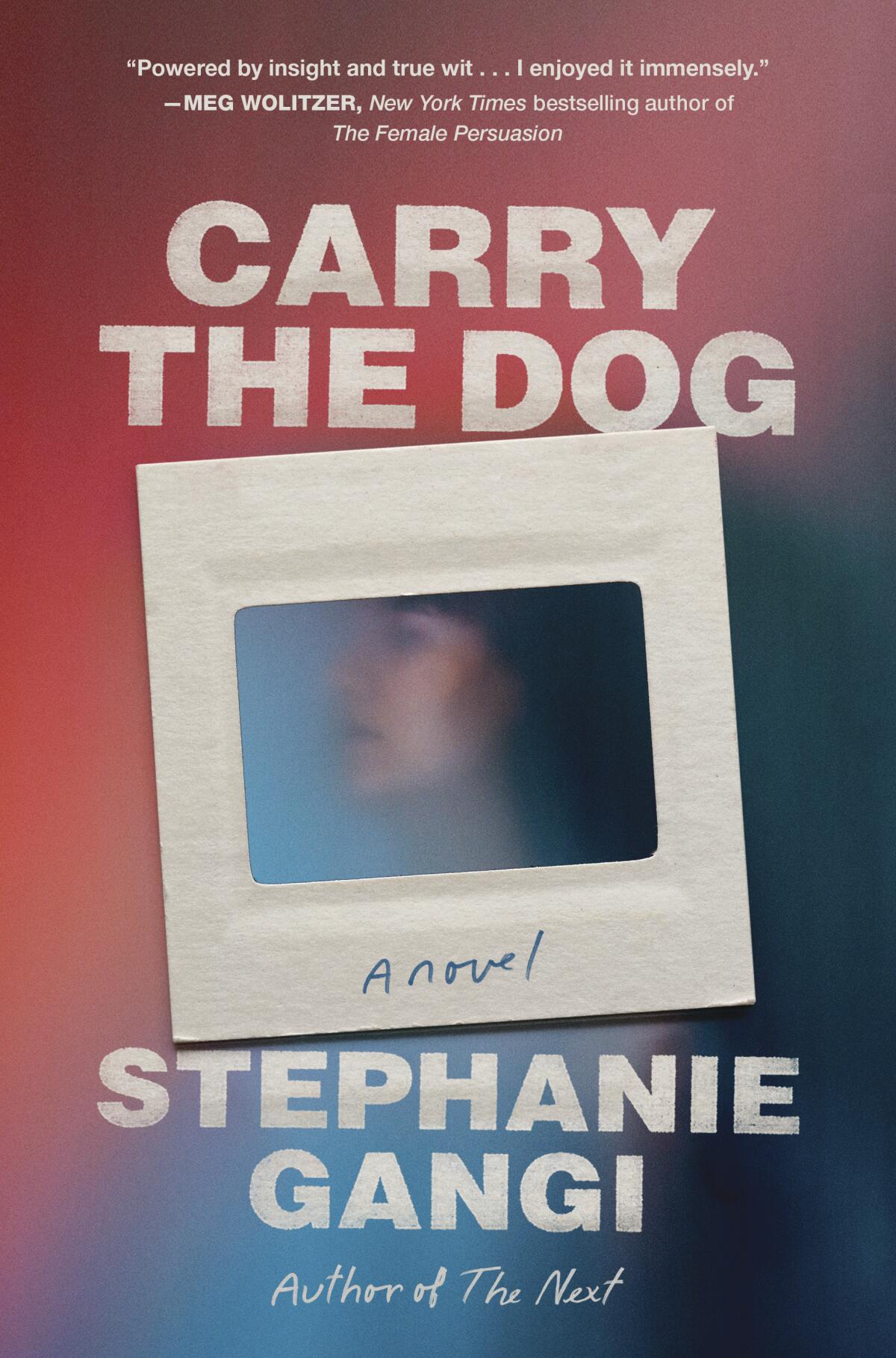A woman battles the exploitative gaze of her late mother in ‘Carry the Dog’

- Share via
On the Shelf
Carry the Dog
By Stephanie Gangi
Algonquin: 288 pages, $27
If you buy books linked on our site, The Times may earn a commission from Bookshop.org, whose fees support independent bookstores.
How does a woman who has been viewed as an object her entire life reclaim herself as a subject? How can she finally “see” herself when she looks in the mirror, rather than the person the world thinks it knows her to be? Stephanie Gangi has some ideas in her second novel, “Carry the Dog.”
Gangi introduces Bea Seger on the cusp of her 60th birthday. Born Berenice Marx-Seger, she is the daughter of the photographer Miri Marx, who became notorious because of what she photographed: her three prepubescent children — Bea and the older twins Henry and Ansel — all of them naked. The “Marx Nudes” series began when Bea was not yet 5 and ended when she was a teen, after an accident that killed Ansel. Shortly after her son’s death, Miri committed suicide.
Nearly 50 years later, Bea has been contacted by two organizations interested in reviving her mother’s work. The first is the Museum of Modern Art, one of whose curators tells her that her mother was a feminist visionary, “a radical departure from the traditional family values of that era. She thinks Miri’s photographs showed that childhood is dark, innocence is a myth, motherhood is a trap, and art — Art — will set you free.”
The other interested party is a Hollywood producer, who gives her the razzle-dazzle pitch at a dinner arranged by her ex-husband: “A biopic with a budget. A name writer. A woman director. Possibly. A serious cast. Oscar-caliber. Classy.”
Both these people purport to have greater insight into her mother — and even herself — than Bea does, an objectifying presumptuousness that is threaded through the novel. Gangi dramatizes this complex theme through various characters in Bea’s life. Her ex-husband, Gary, is an aging rock star who still attracts young female fans on the strength of an old hit song Bea had written (without so much as a songwriting credit). Half-sister Echo has come to New York to pursue a music career. Down in a Florida care home lives her father, Albert, afflicted with dementia. And she has lost touch with her surviving brother, Henry, who went off to college after their mother died and never looked back.
Jessica Chastain’s performance as the queen of ‘70s and ‘80s American televangelism outpaces this otherwise pedestrian biopic directed by Michael Showalter.
Miri Marx might bring to mind the real-life photographer Sally Mann, criticized for the intimate photos in “Immediate Family.” Gangi makes the connection explicit while highlighting the differences between Mann’s work (published in the early 1990s) and fictional Miri’s 1960s images. Bea reflects that, where Mann’s children look natural, the Marx kids struck poses that were stylized, eroticized. Mann’s “kids look like themselves, except naked. We don’t. We look nude.”
For Bea, 60 is a milestone birthday like no other. Looking in a mirror, she is constantly surprised that the woman who stares back at her doesn’t resemble her imagined self. She uses Botox, makeup and various “anti-aging” products in a regimen Gangi describes in resonant detail.
Theorists have posited, based on readings of Freud and Marx, that women are passed along as fetish objects — commodity fetishes — with beauty as the pervading source of their value. A woman peering into the mirror, they say, can’t actually see herself, but only her price. How, then, would an aging woman see herself when she has been fetishized from the age of her earliest memories, and by her own mother?

Gangi cleverly shows how entangled Bea is in this worldview. Constrained by her roles as her mother’s unwilling model and her ex-husband’s trophy wife, she jumps to conclusions about her half-sister, misreads sexual cues, struggles to find depth beneath the surface. At the same time, Gangi invokes other senses — the sudden smell of her mother’s tobacco smoke, for example — to signal that Bea’s most intimate memories are not accessible through what she sees.
Photographs are two-dimensional; Bea becomes only too keenly aware of how others impose their own meanings onto them. Her memories reach back to the moments her mother’s most famous photos were taken, giving the lie to the facile interpretations of strangers. The MOMA curator, Violet Yuen, has researched Miri Marx for years, and Bea hopes such deep study will reveal the truth exposed in the children’s gestures.
“Let her sort me out, because Dr. Yuen knows me,” she thinks. “She has lowered that boom down and swept its icy light across every millimeter of the Marx children. My body .... She has examined my eyes in the photographs. She can see we were coerced. Can’t she?” But Dr. Yuen is only interested in the artist’s vision, not her subjects. With the would-be filmmaker, the red flags are of an even brighter hue.
Andrew Nemerov’s ‘Fierce Poise: Helen Frankenthaler and 1950s New York’ charts the rise of an Abstract Expressionist painter knocked for her privilege.
Bea knows her mother’s photos lie; as the plot develops, she tries to understand Miri’s motivation for taking them. Where did that artistic vision come from? Again, Bea’s other senses offer better clues: Hearing her mother’s voice on an interview triggers a wave of visions — memories — that allow her to see the world more fully. Bea realizes she needs to do more than engage with the work; she must find her surviving brother.
Susan Sontag wrote that reading forces us to engage our analytical brains in order to interpret them, whereas photographs are (deceptively) perceived as “miniatures of reality.” Gangi finds a way in “Carry the Dog” to write a novel of ideas — not a favored American genre — that takes up critiques of visual culture within a very personal context: a novel about aging and coming to terms with childhood trauma.
By placing these conundrums inside the body of a 60-year-old woman experiencing a long-delayed coming of age, she speaks to the many women I know who are going through this transition. It’s a deeply ironic moment, in a way: to perceive themselves, finally, as themselves, even as they are becoming invisible to the world that has fetishized them. Women are raised from infancy to chase the male gaze rather than the male intellect. It’s not surprising that when that gaze turns away, a woman’s sense of self might change.
When such a change is touched on in books or film, too often it’s a source of tragedy, even madness. Gangi, in refreshing contrast, argues that invisibility is freeing. Once Bea sides not with her observers but with her own self, she gains empathy for those around her. Photography presents a flat world to us; absent the dimension of time in which the events were occurring and absent the interior emotions of its subjects, any knowledge gained from a photograph will always make an object of the photographed. It is hard to really see yourself in a world built solely on what can be seen.
Sally Mann’s examination of life, death and decay
Berry writes for a number of publications and tweets @BerryFLW.
More to Read
Sign up for our Book Club newsletter
Get the latest news, events and more from the Los Angeles Times Book Club, and help us get L.A. reading and talking.
You may occasionally receive promotional content from the Los Angeles Times.








